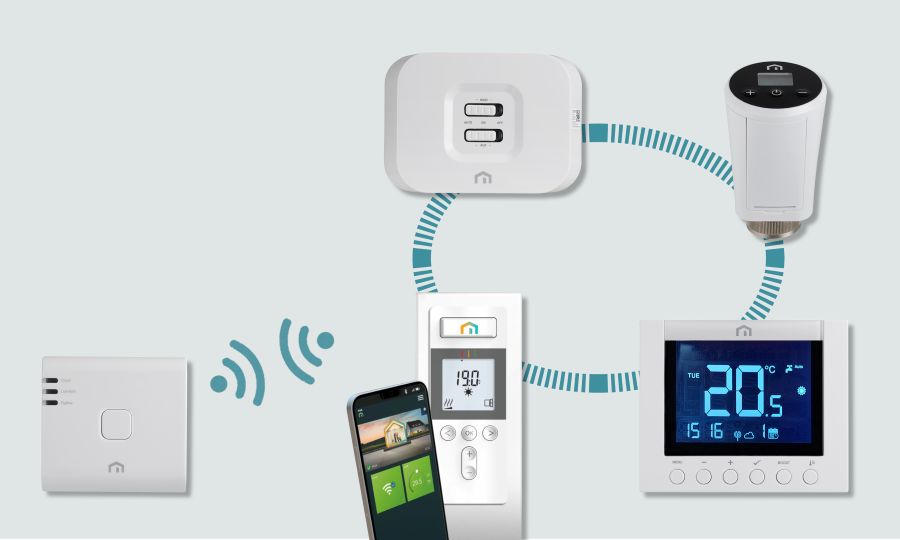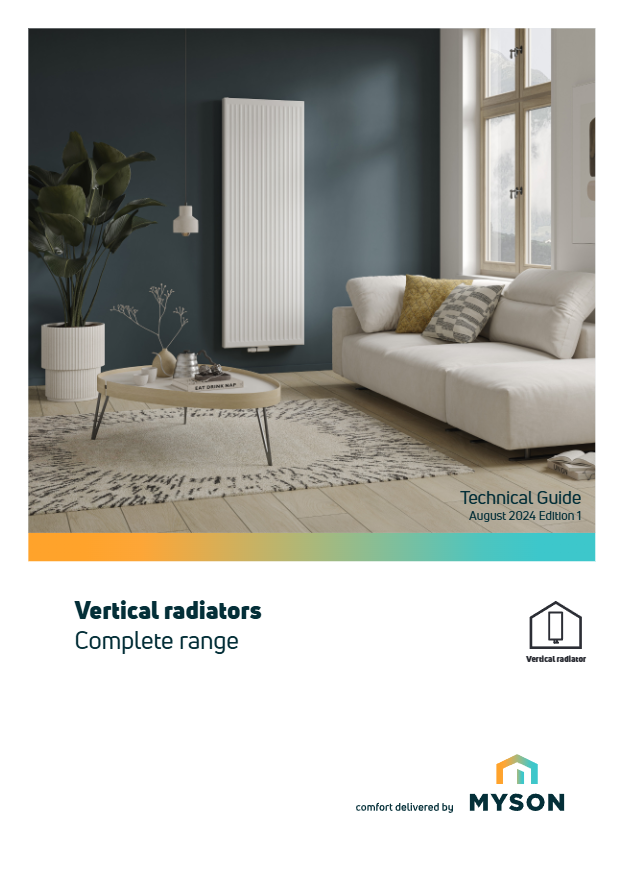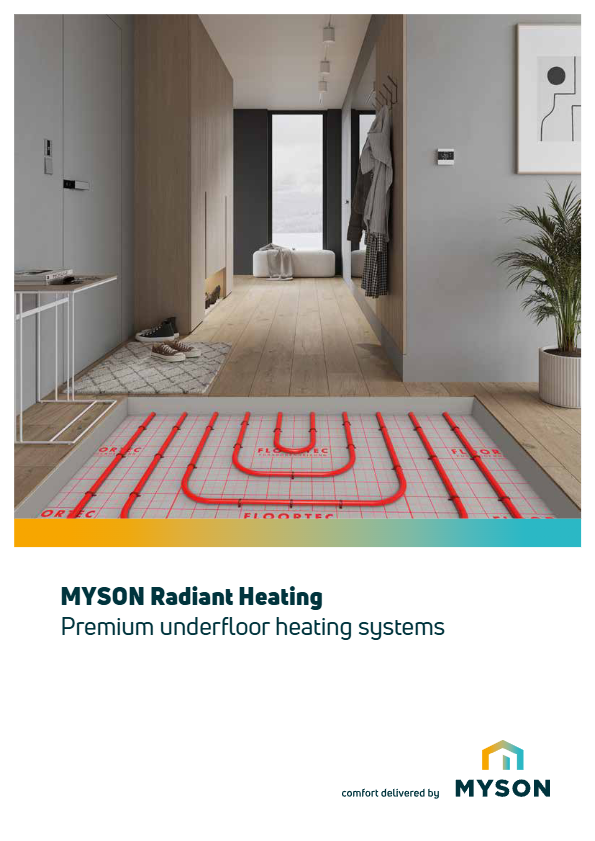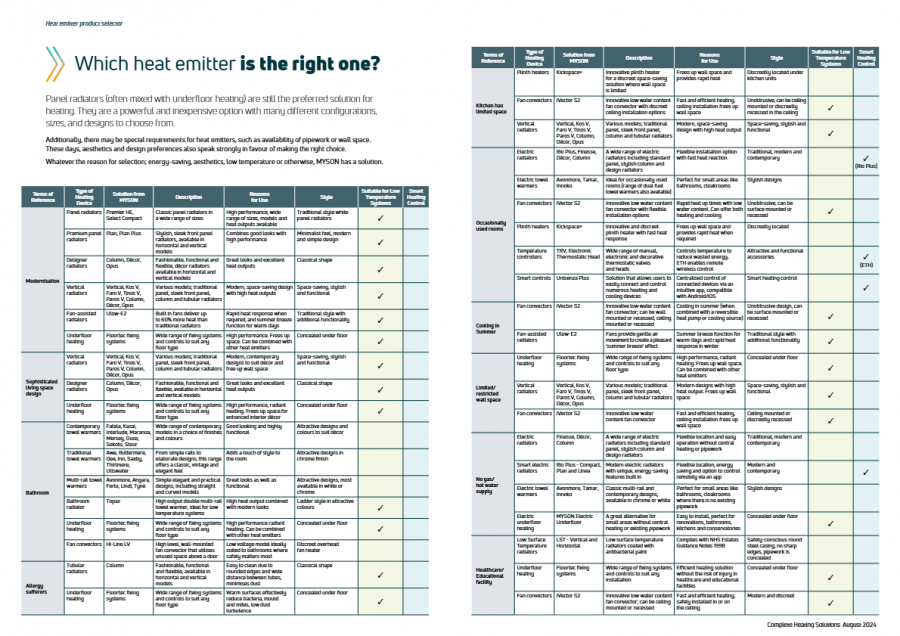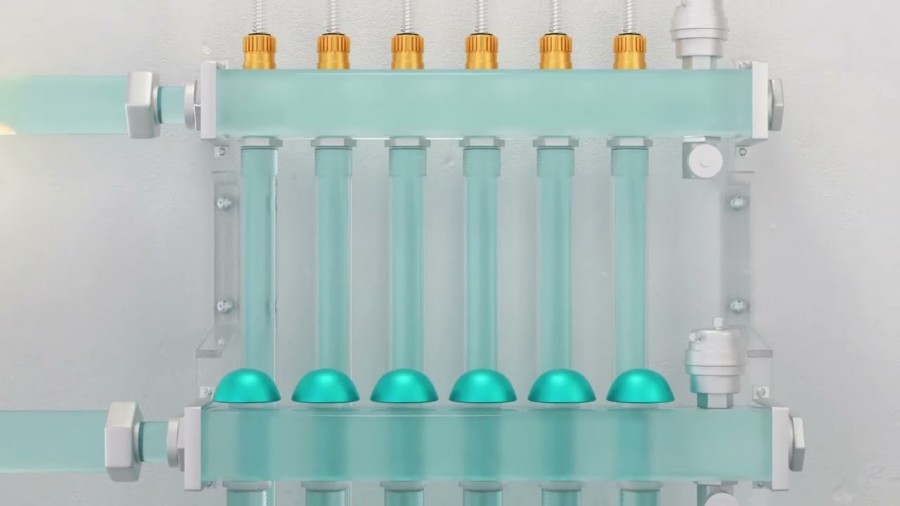When it comes to installing or updating a heating system, people often feel they have to choose between underfloor heating and radiators. However, there is no ‘one size fits all’ approach for heating a building, and both types of heat emitters can be combined. In fact, in both new and renovated buildings, there is a noticeable growth in demand for such hybrid heating systems. And when linked to a user-friendly control system, it’s easy to manage both the underfloor heating and radiators optimally and enjoy the best of both worlds. Let’s take a closer look at how to design, install, and maintain systems that combine underfloor heating and radiators.

Underfloor heating vs. radiators
Each building is individual and therefore differs in terms of heating needs and energy consumption. In older buildings, radiators are generally operated with high system temperatures of up to 75°C, ie. at the coldest outdoor temperatures. After such a building has been energetically renovated, the supply water temperature can be reduced by to up to 45°C with modern panel radiators (or even further with fan-assisted radiators or fan convectors). Radiators are ideal for quickly heating individual rooms and are therefore a popular choice in both new and older houses where rapid heat is required, eg. guest rooms, bedrooms, children's rooms, offices, etc. Underfloor heating systems operate at lower temperatures (30-45°C) by default, offering even heat distribution and energy efficiency, especially when paired with a heat pump. They are particularly suited for bathrooms, living and dining areas.
Both underfloor heating and radiators have their pros and cons. Underfloor heating, for example, frees up valuable wall space, offers the comfortable feel of warmth, and can be split into zones which allows you to set a preferred temperature per room or zone. Radiators, on the other hand, react fast to temperature changes in the room due to their lower water content and lower thermal mass.
Discover our complete radiator range
Why combine underfloor heating and radiators?
“As one of few manufacturers to offer both underfloor heating and radiators, we believe that a combined heating system is a more complete solution that offers many advantages”, says Nabeel Javaid, Market & Applications Product Specialist at Myson UK. “Some situations might be best suited to one or the other but, thanks to technological developments and product innovation, underfloor heating and radiators can both be installed in various areas of a building. This way you create an optimal heating system that’s flexible and energy efficient.”
Key advantages of combining underfloor heating and radiators
- Zoned heating control: underfloor heating can easily be split into separate zones thanks to separate heating circuits and installation distances, while radiators can be installed freely in single rooms, depending on the zone. This allows end users to adjust temperatures in individual rooms based on their specific needs and habits, enhancing energy efficiency and reducing the amount of wasted energy.
- Comfort: the complementary nature of underfloor heating with radiators boosts the overall comfort. “The bathroom is a perfect example of a room which benefits from the combination of underfloor heating and radiators”, says Nabeel. “Underfloor heating creates a consistently warm floor that’s very comfortable to walk on barefoot. It also helps to dry wet floors faster. A radiator is a great addition to help boost the temperature, when needed, for optimal comfort in the bathroom.”
- Energy efficiency: a combined system offers great energy efficiency, especially when you combine underfloor heating with low-temperature radiators and a heat pump or condensing boiler.
- Flexibility in design: this hybrid approach offers greater flexibility in design, particularly for renovations. Radiators are a great solution for spaces where retrofitting underfloor heating may be challenging, while underfloor heating can seamlessly integrate into open-plan areas or bathrooms. This allows for the heating system to be fully tailored to the building layout and the end users’ lifestyle.
Key technical considerations
According to Nabeel, the key to an optimal result lies in the considered combination of the different parts of the system. “As experts in heating solutions, we are able to help our customers optimise that combination in 4 important facets of any heating system: the system design and planning, the pipe network and heating circuit temperature differentiation, correct balancing of the emitters, and the control systems.”
Careful system design and planning is a must to ensure a hybrid system works optimally and the various components won’t counteract each other. Zoning, for example, with separate thermostats and control systems, is important to allow each area to operate independently. “Our internal experts are happy to assist in the planning stage to create the best possible heating system, taking into account the different features and purpose of the building. Good planning will also help with the aesthetics by, for example, thinking in advance about how to draw the pipes to the radiators, you can ensure everything is perfectly integrated into the interior without visual disturbance.”
Nabeel continues “The controls play a pivotal role in maximising comfort and efficiency. Zoning technology and smart controls, such as the ones in our Unisenza and Unisenza Plus range, allow for precise temperature management of both type of emitters. What’s more, with the Unisenza Plus app you can easily combine and control every part of the heating system from a single platform, wherever and whenever you want. This helps reduce energy consumption and maintains optimal comfort at all times.”
Find out more about Unisenza Plus controls
Installation tips
Proper installation is of course essential for a successful hybrid heating system that combines underfloor heating with radiators. Meticulous planning and layout design will help to ensure even heat distribution and minimize heat loss.
Temperature differentiation is a key consideration as underfloor heating and radiators generally require different system temperatures. Mixing valves, blending units, or separate circuits can help achieve the appropriate temperatures for each system. Hydronic balancing is also essential to ensure both systems receive adequate flow and pressure. The manifold can effectively control the heat distribution of the underfloor heating while radiator loops can easily be balanced by means of thermostatic radiators valves.
For the underfloor heating system, strategically positioning pipework and manifolds is critical. Manifolds should always be installed in accessible locations near the zones they serve, reducing pipe lengths and enhancing efficiency.
Finally, insulation is also an important element to consider, especially for underfloor heating installations. High-quality insulation beneath the pipes prevents downward heat loss, maximizes efficiency, and keeps floors warm.
Common challenges
Combining radiators and underfloor heating can occasionally present challenges, but with proper planning and proactive solutions, they can be effectively managed. Temperature incompatibility, for example, is a common challenge, as radiators and underfloor heating generally operate at different water temperatures. This can be addressed with blending valves or mixing units and dedicated zone controls, which regulate the water temperature to meet the specific requirements of each system.
Designing and managing separate zones with appropriate controls for underfloor heating and radiators can also be challenging. Incorrect thermostat placement or lack of smart controls can quickly lead to inefficiency and conflicting operation of two parallel control systems. So investing in smart heating systems with programmable thermostats to ensure each area receives the right heat level is not really a luxury in this case.
Errors like incorrect sizing of radiators, improper pipe connections, or inadequate insulation can compromise system performance. We therefore recommend conducting heat loss calculations for each room to size the radiators and the underfloor heating accurately. Also follow manufacturer guidelines for correct underfloor heating pipe spacing. This will prevent uneven heating as well as time-consuming installations.
Conclusion
In this article we’ve demonstrated that combining underfloor heating and radiators in a hybrid system offers the best of both worlds. By carefully planning the system layout, addressing technical considerations like temperature differentiation and hydronic balancing, and leveraging smart controls for zoning, you can create a tailored heating solution that maximizes comfort and efficiency.
If you have any questions regarding the combination of underfloor heating and radiators or need our support with system design or product selection, please don’t hesitate to get in touch and our experts will be happy to assist.
Get in touch









